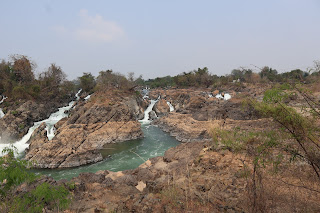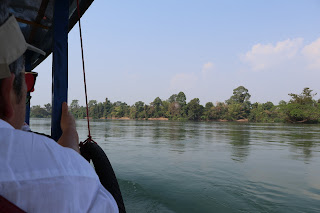About 1.5km downriver from Ban Khon is a raging set of rapids known locally as Tat Somphamit but referred to by just about everyone else as Li Phi Falls.
Li Phi means ‘trap spirit’ and locals believe the falls act as just that – a trap for bad spirits (of deceased people and animals) as they wash down the river. You’ll never see locals swimming here – mixing with the dead is clearly tempting fate a little too much – and it’s both culturally insensitive and dangerous to do so.
Water churns through the falls at a frenetic pace, especially during the wet season, and we are aware of two travellers who have drowned here in recent years.
Much less risky but thoroughly captivating is watching local fishermen edging out to clear the enormous bamboo traps. During the early rains, a well-positioned trap can catch half a tonne of fish a day. Some traps here and elsewhere in the area have an intake almost 10m long, funnelling fish into a huge basket at its end.
The falls can be reached via the main path heading southwest out of Ban Khon, or on a smaller, shaded and more attractive path that passes through the wat and avoids the trucks full of Thai tourists and their consequent dust. There are plenty of small eat-drink shops at the falls.
|
A group of backpackers embark from Nakasong Village to Det Island. |
|
Sailing from Nakasong Village to Det Island. |
|
Old French Port Don Det.
|
|
Catching the bus that takes us from Det Island to Khon Island. |
|
Entering the Don Khone Somphamit Waterfalls Park. |
|
Children bathing in the river under the wooden pedestrian bridge. |
|
Sign indicating the path to the falls and the swimming area. |
|
Upper Waterfall. |
|
Upper Waterfall panorama. |
|
Close-up of the Upper Waterfall. |
|
Suspension bridge over the Mekong River. |
|
Lower Waterfall. |
|
Lower Waterfall panorama. |
|
Close-up of the Lower Waterfall. |
|
Li Phi Somphamit Temple.
|
|
Lunch at Fleur Du Mekong restaurant. |
|
Historic Bridge Don Det - Don Khon. |
|
Crossing the river from Det island back to Nakasong village. |
See also
Source
Location


































































